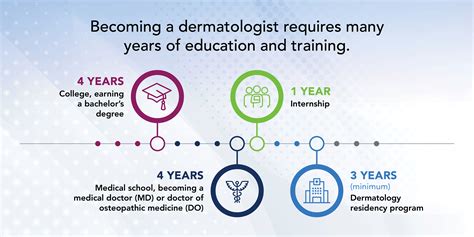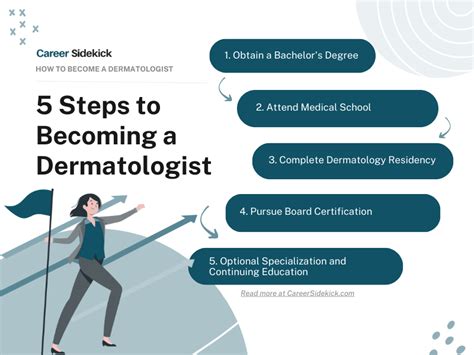Dermatologist Education Requirements

Introduction to Dermatology

To become a dermatologist, one must undergo a significant amount of education and training. Dermatology is the branch of medicine that deals with the study, diagnosis, treatment, and prevention of disorders and diseases related to the skin, hair, and nails. Dermatologists are medical doctors who specialize in this field and must complete a series of educational requirements to practice. In this article, we will explore the educational requirements for becoming a dermatologist, including the steps to become a dermatologist, the importance of dermatology, and the skills required to succeed in this field.
Step 1: Earn a Bachelor’s Degree

The first step to becoming a dermatologist is to earn a bachelor’s degree from an accredited undergraduate institution. Most aspiring dermatologists choose to major in biology, chemistry, or a related field. The undergraduate program typically takes four years to complete and provides a foundation in the sciences, including biology, chemistry, physics, and mathematics. Coursework should include classes in anatomy, biochemistry, and physiology, as these will be essential in understanding the human body and its systems.
Step 2: Take the Medical College Admission Test (MCAT)

After completing the undergraduate degree, the next step is to take the Medical College Admission Test (MCAT). The MCAT is a standardized exam that measures a student’s knowledge in areas such as biology, chemistry, physics, and critical thinking. The exam is typically taken in the spring of the junior year or the fall of the senior year of undergraduate studies. A strong score on the MCAT is essential for gaining admission to medical school.
Step 3: Attend Medical School

The next step is to attend medical school and earn a Doctor of Medicine (M.D.) or Doctor of Osteopathic Medicine (D.O.) degree. Medical school typically takes four years to complete and provides students with both classroom and clinical instruction. The first two years of medical school focus on the basic sciences, including anatomy, biochemistry, and pharmacology. The last two years of medical school provide clinical training in various specialties, including dermatology.
Step 4: Complete a Dermatology Residency Program

After graduating from medical school, the next step is to complete a dermatology residency program. A dermatology residency program typically takes three to four years to complete and provides hands-on training in the diagnosis and treatment of skin, hair, and nail disorders. Residents work under the supervision of experienced dermatologists and gain experience in clinical dermatology, dermatopathology, and dermatologic surgery.
Step 5: Obtain Licensure and Certification

To practice as a dermatologist, one must obtain licensure and certification. A medical license is required to practice medicine in the United States, and certification is offered by the American Board of Dermatology (ABD). To become certified, dermatologists must pass the Certification Examination in Dermatology, which tests their knowledge and skills in the field.
Skills Required to Become a Dermatologist

To become a successful dermatologist, one must possess certain skills, including: * Strong communication skills: Dermatologists must be able to communicate effectively with patients, explaining diagnoses and treatment options in a clear and concise manner. * Attention to detail: Dermatologists must be able to examine patients carefully, taking note of even the smallest details. * Analytical skills: Dermatologists must be able to analyze test results and medical histories to make accurate diagnoses. * Compassion and empathy: Dermatologists must be able to provide emotional support to patients, particularly those with skin cancer or other serious conditions.
💡 Note: Becoming a dermatologist requires a significant amount of education, training, and dedication. It is essential to stay focused and motivated throughout the process.
Importance of Dermatology

Dermatology is an essential field of medicine, as skin, hair, and nail disorders can have a significant impact on a person’s quality of life. Dermatologists play a critical role in: * Diagnosing and treating skin cancers: Dermatologists are trained to diagnose and treat skin cancers, including melanoma, basal cell carcinoma, and squamous cell carcinoma. * Managing chronic skin conditions: Dermatologists help patients manage chronic skin conditions, such as acne, psoriasis, and eczema. * Improving skin health: Dermatologists provide guidance on skin care and prevention, helping patients maintain healthy, glowing skin.
| Step | Description | Duration |
|---|---|---|
| 1. Earn a Bachelor's Degree | Complete undergraduate degree | 4 years |
| 2. Take the MCAT | Take the Medical College Admission Test | 1 day |
| 3. Attend Medical School | Complete medical degree | 4 years |
| 4. Complete a Dermatology Residency Program | Complete hands-on training in dermatology | 3-4 years |
| 5. Obtain Licensure and Certification | Obtain medical license and certification in dermatology | Varies |

In summary, becoming a dermatologist requires a significant amount of education, training, and dedication. By following the steps outlined above and possessing the necessary skills, one can become a successful dermatologist and make a positive impact on the lives of patients. The field of dermatology is constantly evolving, and staying up-to-date with the latest advancements and technologies is crucial for providing the best possible care. With the right education, training, and mindset, anyone can pursue a rewarding career in dermatology.
What is the average salary of a dermatologist?

+
The average salary of a dermatologist varies depending on factors such as location, experience, and type of practice. However, according to the Bureau of Labor Statistics, the median annual salary for dermatologists is around $425,000.
How long does it take to become a dermatologist?

+
Becoming a dermatologist typically takes 11-12 years of education and training after high school. This includes four years of undergraduate studies, four years of medical school, and three to four years of residency training.
What are the most common skin conditions treated by dermatologists?

+
Dermatologists treat a wide range of skin conditions, including acne, psoriasis, eczema, skin cancer, and melanoma. They also provide cosmetic treatments, such as Botox and fillers, to improve the appearance of the skin.



